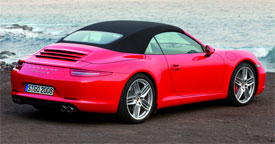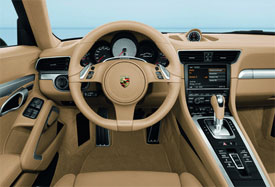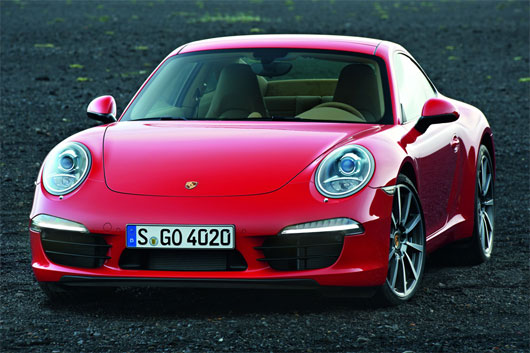2012 Porsche 911
An all new Porsche 911 is truly a rare thing, as there have been just 6 generations of the iconic sports car in its 48 years of production. The most recent 997 debuted in 2005 with not only increased performance, but more technology and luxury as well. Now this 7th generation 911 looks to bring even more of the cutting edge to this fabled label. But is this a car too far?
At first glance, it doesn’t appear like anything extreme, but the 2012 Porsche 911, dubbed the 991 is indeed all-new - as 90% of its parts are fresh. In silhouette, the iconic shape and sloping roofline are all there, but wheelbase has grown by 4-inches to 96.5, while overall length is up just one inch to 176.8. Roof height is down half an inch, front track is wider, larger air intakes dominate the front end, and bigger 20-inch wheels are standard on the Carrera S.
Bi-Xenon headlights are also standard, while corner lighting from the Dynamic Light System is optional. The new sunroof is a win-win. It slides over the top of the roof, and not inside it as before, allowing for both the lower overall height and additional headroom. Wide hips still dominate the rear view and new LED tail lights flash under hard braking to warn those following too closely. An active rear spoiler deploys automatically at 75 miles-per-hour.
 While the body is larger, it’s lighter than before, helping the 991, in Carrera S PDK trim, weigh in a tad less at 3,120 pounds. It’s difficult to tinker with an icon, making it look familiar, yet fresh. We feel Porsche has done a very good job with the new 911.
While the body is larger, it’s lighter than before, helping the 991, in Carrera S PDK trim, weigh in a tad less at 3,120 pounds. It’s difficult to tinker with an icon, making it look familiar, yet fresh. We feel Porsche has done a very good job with the new 911.
A heavily revised 3.8-liter flat-6 engine powers the Carrera S. Horsepower is up 15 to 400, while torque climbs 15 to 325 pound feet; the base Carrera gets a new, smaller 3.4-liter. Fuel economy is up in both engines by about 15%. Actual Government Fuel Economy Ratings for our PDK equipped Carrera S are 20-City and 27-Highway on Premium grade gas. Helping to achieve those numbers, is an all-new, industry first 7-Speed manual transmission; but, most buyers will opt for our car’s 7-Speed PDK automatic.
Acceleration is as spirited as you’d expect, with the PDK in Launch Mode, you can dispatch 60 in just 3.9-seconds; the quarter mile flies by in 12.1-seconds with a trap speed of 114 miles-per-hour. The 911 is certainly one high tech piece of machinery; there’s a lot of electronic assist, from Torque-Vectoring, electro-mechanical steering, Dynamic Chassis Control, and a downhill engine coasting function that disengages the PDK transmission. But unlike most rivals, everything happens so seamlessly you’re rarely aware of any intervention.
One thing we did notice is a new auto start/stop function. It works very well, and is also easily disabled, and it will turn off automatically when you engage Sport Mode. Sport Mode also ratchets up engine response, increases stability control threshold, gives the PDK more aggressive shifts, and stiffens up new dynamic engine mounts, which we found out at through the high speed corners of Savannah’s Roebling Road Raceway. Both front and rear suspensions have been redesigned and consist mostly of aluminum.
Brakes are both bigger and lighter, and Ceramic discs continue to be an option. Our car didn’t have them, but even after two days at the track, 100 foot super short stops from 60 were the norm.
 Despite its famous rear mounted engine, the new 911 is one of the most comfortable and forgiving sports cars ever. The interior has taken a bit of a sportier turn compared to the GT-car- like 997. Most controls lie in the “Panamera-inspired” center console that rises up to meet the dash, putting the shifter, just inches from the wheel.
Despite its famous rear mounted engine, the new 911 is one of the most comfortable and forgiving sports cars ever. The interior has taken a bit of a sportier turn compared to the GT-car- like 997. Most controls lie in the “Panamera-inspired” center console that rises up to meet the dash, putting the shifter, just inches from the wheel.
But, it’s not sparse. Just about every surface is covered in high quality leather, and plenty of luxury amenities are present. 7-inch, touch screen navigation is standard, as are power adjustments for both front seats. Rear seats are still more useful for luggage than people, and cargo capacity up front stays the same at 4.8 cubic-feet.
Gauges remain the classic 5-dial setup, with a large tach right in the middle and a dash mounted timer indicates you’ve opted for the Sport Chrono Package. A new Sound Symposer option lets you pipe additional ambiance into the cabin if you want to hear, as well as feel, the engines full wrath.
The 2012 Porsche 911 Carrera S is on sale now, with a price that is up slightly over last year to $97,350. The base Carrera rings in at $83,050.
Purists have given Porsche grief over the past few years for diversifying their line-up but selling all of those big sedans and SUV’s has just enabled them to make a much better 911. Sure, more and more electronics have creeped into the driving equation. But when they work this well, it’s hard to complain about them. So, if you have a chance, grab the wheel of a new 911, find some twisties, and enjoy the ride… We sure did!
Specifications
- Engine: 3.8-liter
- Horsepower: 400
- Torque: 325 lb-ft.
- 0-60 mph: 3.9-seconds
- 1/4 mile: 12.1 seconds @ 114 mph
- EPA: 20 mpg city/ 27 mpg highway
2024 Polestar 2
More Range And More Power For The Polestar 2
Volvo is well on their way to making the transition to an all-electric brand, but their sister-brand Polestar is already there. Now, we’ve spent lots of time in their all-wheel drive, five-door Polestar 2, having tested it in 2021, and a year later when a two-wheel drive version arrived. But, EV updates are coming quickly. So, let us be your guide for all that’s new with the Polestar 2.
While we are driving more EVs than ever, we’ve also been spending a lot of time recently circling back to ones we’ve previously tested. As in this new era of electrified vehicles, significant updates are arriving quickly, with R&D investments increasing and retrofitting them easier than ever. This is often done through software updates that can even be accomplished over the air. For 2024, the Polestar 2 has indeed gotten some software updates, but some physical ones as well.
Clearly aimed directly at Tesla’s Model 3 when it arrived; the Polestar 2’s build quality was vastly better, but range definitely came up short. So, addressing that was priority No. 1; and for ’24 the Polestar can travel up to 20% farther than before while consuming 9% less energy, and when it comes time to charge it back up, it can do that 34% faster too.
Range in the Single Motor version increases from a max of 270 to 320 miles thanks to a larger 82-kWh battery pack, and that solitary motor now powers the rear wheels, not the front wheels. It’s also bigger, coming in at 220 kW compared to the previous 170 kW front-wheel drive version, going from 231 to 299 horsepower.
Dual Motors keep the same 78-kWh battery, but still sees a boost from 260 to 276 miles and takes advantage of the larger rear motor for a new combined 310-kW output with 421 horsepower. Our test car has the added Performance Pack, which uses an additional 35 kW to deliver 455 horsepower and 546 lb-ft of torque, though max range drops to just 247 miles.
The new battery in rear-drive 2s will also charge faster, now accepting up to 205 kW for an 80% charge in 20 minutes; max for dual-motors stays at 155 kW, which puts an 80% charge at 34 minutes. Using 32 kWh of electricity per 100 miles, the Dual Motor earns a good efficiency rating.
The [Polestar] 2 has always been one of the most enjoyable EVs to drive, even more so now with that additional power coming from the rear motor.
Unfortunately, extremely cold temperatures kept us from seeing that increased range, as we were only on pace for about 194 miles in our test.
The 2 has always been one of the most enjoyable EVs to drive, even more so now with that additional power coming from the rear motor. And especially when equipped with the Performance Pack as it not only includes more power, but adds 20-inch forged wheels, upgraded brakes, and adjustable Ohlins Dual Flow Valve performance dampers. It greatly improves handling prowess without affecting ride quality, and is easily worth the $5,500 charge if you at all enjoy driving.
Even on a 20-degree track day there was plenty of grip through our handling course. No understeer or oversteer, and lots of feedback through the wheel. There was a nice, strong launch off the line that properly planted us firmly in the seat, and rocketed us to 60 in 4.5 seconds. Power delivery stayed pretty intense up until about 80 mph when there was a definite tapering off. Still, it was a 13.4-second quarter-mile at 102 mph; smooth, quiet, and stable the whole way.
When this car debuted, its Google-based infotainment setup was a novelty, but since then, more and more manufacturers are just “Googling it” so it doesn’t seem out of place at all. The wireless phone charger is easy to access, and there’s a great Harmon/Kardon sound system and panoramic sunroof to enhance the in-cabin experience. Exteriors have also been enhanced with a smooth grille insert and new wheel choices.
Hatchback practicality means 14.3 cu-ft of easy to access cargo space with split-folding seatbacks for longer items and expanding the space to 38.7 cu-ft. Plus, there’s even a sizeable storage bin up front under the hood.
Single Motor Polestar 2 pricing now starts at $51,300, with Dual Motors starting at $56,700; topping out at $64,400.
For a car manufacturer that hasn’t even been around for a decade yet, Polestar has kept itself busy, totally transforming their latest model in just a few years, making the 2024 Polestar 2 even more appealing. They are certainly off to a good start, and with a host of Polestars just over the horizon, including some all-important utility vehicles, this star will be shining even brighter.
Specifications
As Tested
- Motor Setup: Dual Motor
- Horsepower: 455
- 0-60 mph: 4.5 seconds
- EPA Range: 247 miles
- Efficiency : 32 kWh / 100 miles
- Battery Size: 78-kWh
- Torque: 546 lb-ft
- 1/4 Mile: 13.4 seconds at 102 mph
- MW Test Loop: ~ 194 miles
- Peak Charging Rate: 155 kW











































